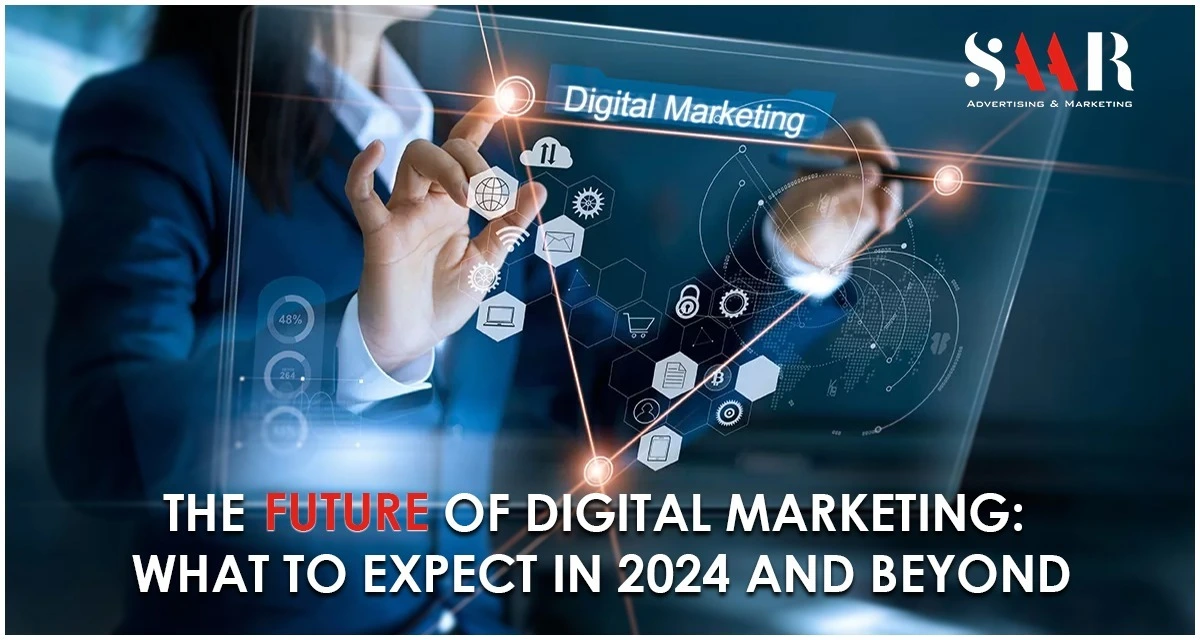
The Future of Digital Marketing: What to Expect in 2024 and Beyond
Digital marketing is continuously evolving. Strategies that work now may become obsolete in a few years due to rising technology and changing customer behavior.
Marketers must foresee where digital marketing will be in 2024 in order to stay ahead of the curve. It is critical to alter your techniques and tools over time in order to keep up with changing industry trends.
Owing to this, today we'll look at the future of digital marketing, focusing on important trends that are expected to affect the scene in 2024.
So whether you're planning next year's marketing strategies or looking for a long-term view of where things are headed, these 2024 digital marketing forecasts can help drive your approach.
Prediction 1: Increase in Automated Marketing
Manual, time-consuming marketing activities are exhausting. Marketers waste time copying and pasting or customizing campaigns across channels when they should be spending it on strategy and innovation.
Marketing automation is expected to become increasingly commonplace by 2024. Platforms like HubSpot, Marketo and Adobe Campaign combine many marketing channels into a unified process.
With marketing automation, tasks like Email marketing, Social media posting, Lead nurturing, Sales CRM synchronization, Personalization of landing pages, Lifecycle messaging, Attribution reporting, and more can be automated depending on triggers, user involvement and events. This enables marketers to work smarter and expand their efforts to achieve greater outcomes.
Prediction 2: The Demise of Third-Party Cookies and Identifiers
Google has declared that third-party cookies will be blocked in Chrome by 2024. They are already blocked by Apple's Safari and Mozilla's Firefox.
This inhibits marketers' ability to monitor visitors anonymously between sites via cookie-tracking pixels.
The loss of third-party cookies will have an impact on the future of digital marketing and so does on digital marketers who rely largely on them for data.
And because of this, we'll see an increase in:
• Direct acquisition of first-party data from owned channels such as email subscribers, site behavioral data and loyalty programs.
• Contextual advertising based on the content of a website rather than the identity of the visitor.
• Privacy-conscious strategies such as data clean rooms and anonymized data exchange among brands.
• The use of identifiers such as email addresses or logins as opposed to unidentified tracking.
In a post-third-party cookie future, marketers will need to develop new methods to tailor advertising and consumer experiences.
Prediction 3: Conversational Marketing's Adoption
Chatbots, AI-powered virtual assistants and interactive messaging are changing the way people engage with technology. We're moving away from static forms and pre-programmed menus to natural conversation.
By 2024, every brand might begin using conversational interfaces across all digital touchpoints. Voice search optimization will become the norm. Chatbots on websites, applications and messaging systems will also be common.
Conversational AI will become more flexible and responsive as NLP becomes smarter.
Consumers who are digital natives will prefer texting a business over traditional static communication options. Conversations with smart brands will meet them where they are already.
Prediction 4: Shoppable Social Commerce
Social media networks are evolving into shopping places. Having resisted e-commerce for years:
• Instagram now permits in-app purchases of products.
• Pinterest users may purchase things that have been pinned without leaving the site.
• Facebook/Meta is working hard to provide shoppable live-streaming features.
• TikTok Shopping is in beta testing for smooth in-video transactions.
By 2024, social media will be a major source of digital commerce. Direct shopping via social content, influencers and community ties is convenient and encourages purchases.
Prediction 5: The Rebirth of Digital Out-of-Home Advertising
Thanks to connectivity and interactivity, DOOH (digital out-of-home) advertising on public screens, kiosks, billboards, transport displays and other locations is seeing a revival.
DOOH ad expenditure which was already increasing prior to the epidemic, is expected to exceed $20 billion by 2024.
Digital OOH, as opposed to static signage, enables:
• Dayparting advertisements based on the time of day, weather, traffic and location.
• Personalization, depending on the demographics and context of the viewer.
• Mobile data integration for retargeting and offline attribution.
DOOH advertising also complements mobile advertising. Furthermore, geofencing and location data are used by marketers to expand the reach of screens into cross-device customer journeys.
Prediction 6: The Use of AI-Generated Creativity
Marketers today rely on creatives and content teams to create display advertisements, social posts, website text and other assets. However, AI is likely to revolutionize creative development.
AI copywriting and content solutions like Jasper, Rytr and Copy.ai can develop text-based creative matched to objectives, parameters and voice requirements in seconds.
AI is used by platforms such as Anthropic to build full landing pages and marketing websites. And generative AI such as DALL-E, generates visuals and art on demand.
AI creative automation is expected to become ubiquitous by 2024. Marketers may immediately generate thousands of tailored ad combinations that correspond to campaign objectives and evaluate the best performers.
AI does not take the place of human inventiveness. However, it adds value to the efforts by doing the hard work for early conception and iteration.
Key Takeaway
Five years from now, the future of digital marketing will look very different. So are your talents, procedures and technology stack ready for the upcoming evolution?
If not then here are some crucial suggestions for future-proofing your marketing:
• Invest in automation and artificial intelligence technologies to optimize effect when resources compress.
• Create first-party data capabilities before third-party cookies become obsolete.
• Gain experience with innovative digital experiences such as conversational interfaces, virtual reality and shoppable streaming video.
• Create an owned audience through websites, email, mobile applications and other channels that are not reliant on third-party platforms.
• Test and improve measurement models in a world without third-party cookies.
• Take part in retail media, affiliate programs and social monetization through commerce.
• Use agile processes in strategy, creativity, experiences, and insights to adapt rapidly to changes.
While 2024 may seem far away, the rate of change requires forward-thinking companies to begin changing today. So use these forecasts to plot your route so that your marketing is prepared to succeed in the future consumer and technological landscape.




